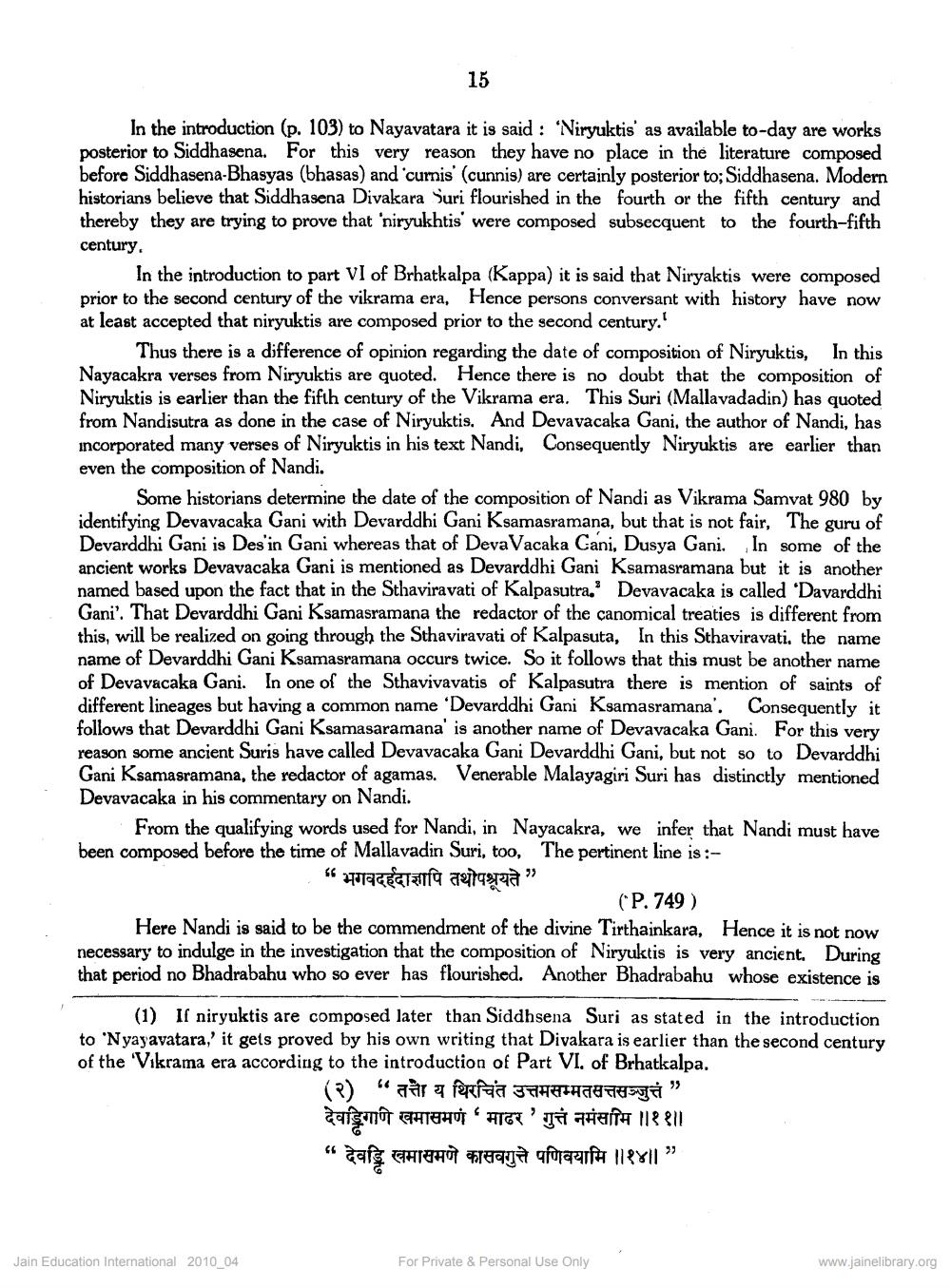________________
15
In the introduction (p. 103) to Nayavatara it is said : "Niryuktis' as available to-day are works posterior to Siddhasena. For this very reason they have no place in the literature composed before Siddhasena-Bhasyas (bhasas) and curnis (cunnis) are certainly posterior to: Siddhasena. Modern historians believe that Siddhasena Divakara Suri flourished in the fourth or the fifth century and thereby they are trying to prove that 'niryukhtis were composed subsecquent to the fourth-fifth century.
In the introduction to part VI of Brhatkalpa (Kappa) it is said that Niryaktis were composed prior to the second century of the vikrama era, Hence persons conversant with history have now at least accepted that niryuktis are composed prior to the second century.'
Thus there is a difference of opinion regarding the date of composition of Niryuktis, In this Nayacakra verses from Niryuktis are quoted. Hence there is no doubt that the composition of Niryuktis is earlier than the fifth century of the Vikrama era. This Suri (Mallavadadin) has quoted from Nandisutra as done in the case of Niryuktis. And Devavacaka Gani, the author of Nandi, has incorporated many verses of Niryuktis in his text Nandi, Consequently Niryuktis are earlier than even the composition of Nandi.
Some historians determine the date of the composition of Nandi as Vikrama Samvat 980 by identifying Devavacaka Gani with Devarddhi Gani Ksamasramana, but that is not fair, The guru of Devarddhi Gani is Des'in Gani whereas that of Deva Vacaka Cani, Dusya Gani. In some of the ancient works Devavacaka Gani is mentioned as Devarddhi Gani Ksamasramana but it is another named based upon the fact that in the Sthaviravati of Kalpasutra. Devavacaka is called 'Davarddhi Gani'. That Devarddhi Gani Ksamasramana the redactor of the canomical treaties is different from this, will be realized on going through the Sthaviravati of Kalpasuta, In this Sthaviravati, the name name of Devarddhi Gani Ksamasramana occurs twice. So it follows that this must be another name of Devavacaka Gani. In one of the Sthavivavatis of Kalpasutra there is mention of saints of different lineages but having a common name 'Devarddhi Gani Ksamasramana'. Consequently it follows that Devarddhi Gani Ksamasaramana' is another name of Devavacaka Gani. For this very reason some ancient Suris have called Devavacaka Gani Devarddhi Gani, but not so to Devarddhi Gani Ksamasramana, the redactor of agamas. Venerable Malayagiri Suri has distinctly mentioned Devavacaka in his commentary on Nandi.
From the qualifying words used for Nandi, in Nayacakra, we infer that Nandi must have been composed before the time of Mallavadin Suri, too, The pertinent line is :"Tatafa aetata"
(P. 749 ) Here Nandi is said to be the commendment of the divine Tirthainkara, Hence it is not now necessary to indulge in the investigation that the composition of Niryuktis is very ancient. During that period no Bhadrabahu who so ever has flourished. Another Bhadrabahu whose existence is
(1) If niryuktis are composed later than Siddhsena Suri as stated in the introduction to 'Nyayavatara,' it gets proved by his own writing that Divakara is earlier than the second century of the 'Vikrama era according to the introduction of Part VI. of Brhatkalpa.
(2) "ar a fertfala 3THAT " देवडिगाण खमासमणं 'माढर 'गुत्तं नमसामि ॥११॥ “Jai EHITHƯt Peraga afuauift 118811"
Jain Education International 2010_04
For Private & Personal Use Only
www.jainelibrary.org




